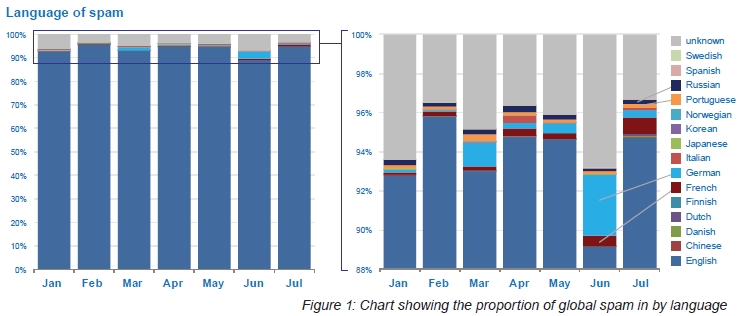Spammers go multilingual, use automatic translation services

Things changed, at least for some of them. Realizing the advantages of market segmentation, certain spammers started segmenting the databases of harvested or emails based on their country of origin, followed by an attempt to go local in terms of spamming by using the native language of the prospective recipients.
Nowadays, spam is not just going multilingual, on demand translation services exclusively marketed to cybercriminals are prone to change the name of the game, allowing them to easily localize the messages for their upcoming malware/spam/phishing campaign to the native language of the targeted audience.
Globally, the majority of spam is in English, and in July around 5%, or 1 in every 20 spam messages, was in non-English language as highlighted in Figure 1. On analyzing the proportion of spam in non-English countries, the volume of English-language spam can often be much less in than English-language countries, suggesting that spammers are targeting countries correctly rather than sending all countries English language spam. For instance, in Germany 46.5% of all spam is in German and 2.5% in French. In The Netherlands, 25% of spam is in the Dutch language while in France, 53% is in French and 4% in German. In Japan, 62.3% of the spam is found to be in Oriental non-English languages and in China, this number is 54.7%.
The ongoing localization as a trend was also confirmed in McAfee's Global S.P.A.M Diaries experiment conducted in 2008 (page 12), where the same countries once again topped the charts for receiving most of the localized spam messages.
- Go through related posts - With or without McColo, spam volume increasing again; Atrivo/Intercage's disconnection briefly disrupts spam levels; Google: Spam volume for Q1 back to pre-McColo levels; Overall spam volume unaffected by 3FN/Pricewert's ISP shutdown; Inside an affiliate spam program for pharmaceuticals
One such service which I've been monitoring since October 2008, remains active and due to its evident partnership with a particular cybercrime-facilitating community can be easily considered the de facto choice for quality-conscious spammers who care about their anonymity - the service keeps no logs for any interaction with prospective customers.
What do you think, would spammers continue using the mass marketing approach and achieve results such as 28 sales based on 350 million spam messages without localization based on the end user's old habit of clicking on spam links, or would they embrace professional translation services on a large scale?
Talkback.